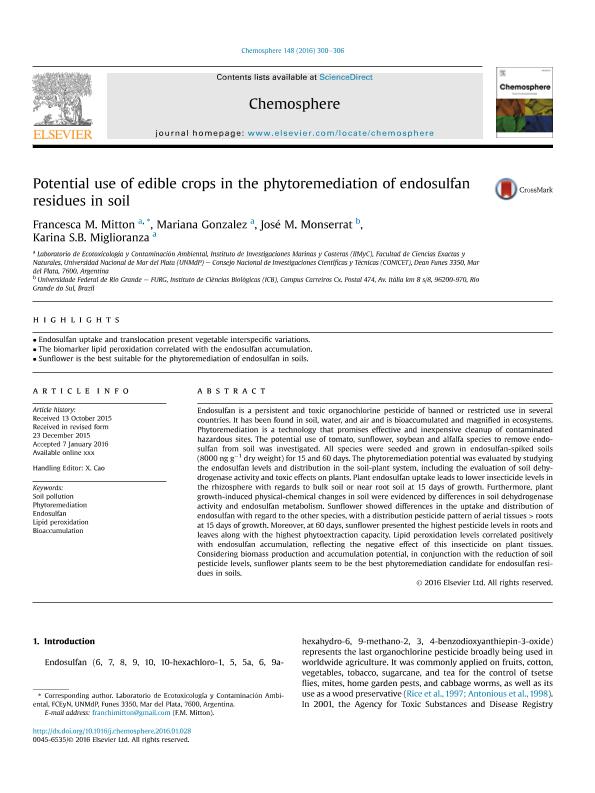Mostrar el registro sencillo del ítem
dc.contributor.author
Mitton, Francesca María

dc.contributor.author
Gonzalez, Mariana

dc.contributor.author
Monserrat, José María

dc.contributor.author
Miglioranza, Karina Silvia Beatriz

dc.date.available
2018-08-30T20:39:24Z
dc.date.issued
2016-04
dc.identifier.citation
Mitton, Francesca María; Gonzalez, Mariana; Monserrat, José María; Miglioranza, Karina Silvia Beatriz; Potential use of edible crops in the phytoremediation of endosulfan residues in soil; Pergamon-Elsevier Science Ltd; Chemosphere; 148; 4-2016; 300-306
dc.identifier.issn
0045-6535
dc.identifier.uri
http://hdl.handle.net/11336/57801
dc.description.abstract
Endosulfan is a persistent and toxic organochlorine pesticide of banned or restricted use in several countries. It has been found in soil, water, and air and is bioaccumulated and magnified in ecosystems. Phytoremediation is a technology that promises effective and inexpensive cleanup of contaminated hazardous sites. The potential use of tomato, sunflower, soybean and alfalfa species to remove endosulfan from soil was investigated. All species were seeded and grown in endosulfan-spiked soils (8000 ng g-1 dry weight) for 15 and 60 days. The phytoremediation potential was evaluated by studying the endosulfan levels and distribution in the soil-plant system, including the evaluation of soil dehydrogenase activity and toxic effects on plants. Plant endosulfan uptake leads to lower insecticide levels in the rhizosphere with regards to bulk soil or near root soil at 15 days of growth. Furthermore, plant growth-induced physical-chemical changes in soil were evidenced by differences in soil dehydrogenase activity and endosulfan metabolism. Sunflower showed differences in the uptake and distribution of endosulfan with regard to the other species, with a distribution pesticide pattern of aerial tissues > roots at 15 days of growth. Moreover, at 60 days, sunflower presented the highest pesticide levels in roots and leaves along with the highest phytoextraction capacity. Lipid peroxidation levels correlated positively with endosulfan accumulation, reflecting the negative effect of this insecticide on plant tissues. Considering biomass production and accumulation potential, in conjunction with the reduction of soil pesticide levels, sunflower plants seem to be the best phytoremediation candidate for endosulfan residues in soils.
dc.format
application/pdf
dc.language.iso
eng
dc.publisher
Pergamon-Elsevier Science Ltd

dc.rights
info:eu-repo/semantics/openAccess
dc.rights.uri
https://creativecommons.org/licenses/by-nc-sa/2.5/ar/
dc.subject
Bioaccumulation
dc.subject
Endosulfan
dc.subject
Lipid Peroxidation
dc.subject
Phytoremediation
dc.subject
Soil Pollution
dc.subject.classification
Meteorología y Ciencias Atmosféricas

dc.subject.classification
Ciencias de la Tierra y relacionadas con el Medio Ambiente

dc.subject.classification
CIENCIAS NATURALES Y EXACTAS

dc.title
Potential use of edible crops in the phytoremediation of endosulfan residues in soil
dc.type
info:eu-repo/semantics/article
dc.type
info:ar-repo/semantics/artículo
dc.type
info:eu-repo/semantics/publishedVersion
dc.date.updated
2018-08-30T15:47:40Z
dc.journal.volume
148
dc.journal.pagination
300-306
dc.journal.pais
Países Bajos

dc.journal.ciudad
Amsterdam
dc.description.fil
Fil: Mitton, Francesca María. Consejo Nacional de Investigaciones Científicas y Técnicas. Centro Científico Tecnológico Conicet - Mar del Plata. Instituto de Investigaciones Marinas y Costeras. Universidad Nacional de Mar del Plata. Facultad de Ciencia Exactas y Naturales. Instituto de Investigaciones Marinas y Costeras; Argentina
dc.description.fil
Fil: Gonzalez, Mariana. Consejo Nacional de Investigaciones Científicas y Técnicas. Centro Científico Tecnológico Conicet - Mar del Plata. Instituto de Investigaciones Marinas y Costeras. Universidad Nacional de Mar del Plata. Facultad de Ciencia Exactas y Naturales. Instituto de Investigaciones Marinas y Costeras; Argentina
dc.description.fil
Fil: Monserrat, José María. Universidade Federal de Rio Grande; Brasil
dc.description.fil
Fil: Miglioranza, Karina Silvia Beatriz. Consejo Nacional de Investigaciones Científicas y Técnicas. Centro Científico Tecnológico Conicet - Mar del Plata. Instituto de Investigaciones Marinas y Costeras. Universidad Nacional de Mar del Plata. Facultad de Ciencia Exactas y Naturales. Instituto de Investigaciones Marinas y Costeras; Argentina
dc.journal.title
Chemosphere

dc.relation.alternativeid
info:eu-repo/semantics/altIdentifier/doi/https://dx.doi.org/10.1016/j.chemosphere.2016.01.028
dc.relation.alternativeid
info:eu-repo/semantics/altIdentifier/url/https://www.sciencedirect.com/science/article/pii/S0045653516300285
Archivos asociados
